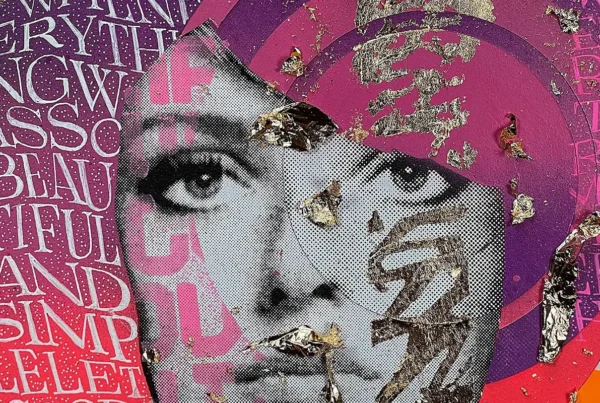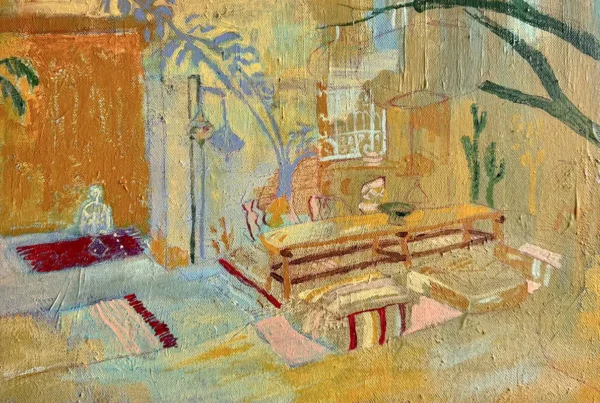Tracing Lines Across Continents
The story of Emon Surakitkoson is one marked by transitions—geographic, cultural, and personal. Born in Thailand in 1985, she left her home country at the age of 19 in pursuit of new opportunities in the United States. Her initial years were spent in the food and beverage industry—navigating survival, identity, and ambition in an unfamiliar landscape. But a pivotal shift came in 2018, when Surakitkoson turned to drawing as an emotional outlet. What began as an exercise in line work quickly evolved into a full-fledged visual language. By 2020, she made the bold leap into becoming a full-time artist, forging a distinctive practice centered on abstract monochrome compositions and deeply rooted in her lived experience.
Now based in the Baltimore and Washington, D.C. area, Surakitkoson has carved a space for herself not only as an artist but also as a community builder. Her pieces have found homes in major hospitality spaces, where her signature black-and-white sculptural works add contemplative energy to corporate and public settings. What sets her apart is a self-taught, process-driven approach that refuses to mimic existing templates. Instead, her work expresses resilience, cultural duality, and a meditative inquiry into perception and space.
What makes Surakitkoson’s trajectory so compelling is the organic authenticity of her rise. Without formal art training, she found her voice through relentless experimentation and quiet tenacity. Her early drawings grew into large-scale mixed media compositions, shaped by handmade tools and materials that reflected both necessity and innovation. The minimalist color palette—primarily black, white, and gray—is not a restriction but a philosophical and aesthetic choice. Through contrast and texture, she captures complexity without distraction, inviting viewers into a contemplative dialogue about belonging, visibility, and emotional nuance. Surakitkoson’s visual storytelling resists spectacle and instead encourages a deeper, more tactile engagement with the ordinary and extraordinary alike.
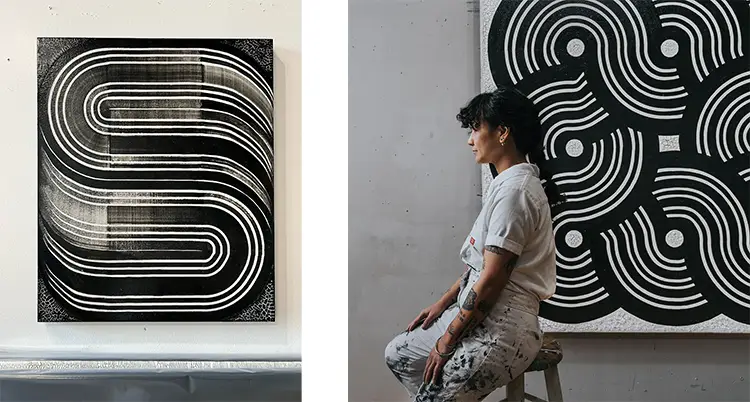
Emon Surakitkoson: Sculpting Identity Through Abstraction
Surakitkoson’s work thrives on paradox: the simplicity of her materials contrasts with the depth of feeling they evoke. Her paintings are frequently described as sculptural—not only in their physical texture but in the sense of weight and presence they command. Her process typically begins with a single, uninterrupted brushstroke. This first motion sets the rhythm, allowing shapes to emerge organically as she builds compositions layer by layer. Many of her brushes are handmade, crafted from scratch in moments of necessity, but now fundamental to her studio routine. These tools—personal, functional, and symbolic—emphasize her belief that the act of making is just as meaningful as the final outcome.
She describes her style as one centered on “balance,” both visual and emotional. In her monochromatic pieces, contrasts are not merely aesthetic but metaphorical, representing the internal push and pull of dislocation. Rather than focus on narrative depictions, she turns toward abstraction to distill these feelings. Textures mimic water currents, sky, and land—an elemental triad that structures her compositions and reflects her meditative approach. The artwork becomes not only an object to observe but a space to enter—where each brushstroke offers a moment of stillness or tension, depending on the viewer’s proximity and perception.
Surakitkoson’s artistic philosophy pushes back against imposed assumptions. She intentionally works on large-scale pieces using industrial power tools. Each canvas, wood panel, or sculptural element becomes a declaration of autonomy. Her compositions feature abstract “characters” that traverse invented environments, acting as visual avatars of selfhood navigating unfamiliar terrain. Through this approach, Surakitkoson explores how identity is continually reconstructed—not through assimilation, but through the synthesis of multiple truths.
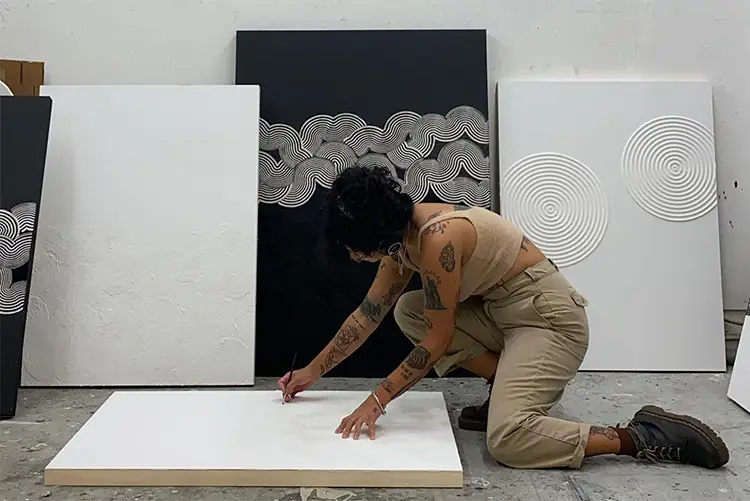
Tools of Translation and the Language of Connection
For Surakitkoson, art functions as a third language—an intuitive system of communication beyond Thai and English. In many ways, this visual language offers her a platform to assert agency while inviting others into shared experiences of ambiguity and clarity. Her immigrant background, rather than a barrier, informs the heartbeat of her artistic practice. Each piece represents a negotiation: between cultures, between surface and depth, between external perception and internal reality. This negotiation is particularly visible in her technique of segmenting artworks into three vertical zones—mirroring sky, water, and land—to create equilibrium through elemental grounding.
The emotional depth of her pieces lies in their ability to reward both distance and intimacy. From afar, the viewer is confronted with structured minimalism, but up close, the surfaces reveal delicate gestures, subtle imperfections, and complex layering. The lines, textures, and rhythms of her work become quiet analogies for human relationships and the unspoken layers that shape them.
Her success has been matched by a commitment to making the art world more accessible. Surakitkoson has organized artist meetups that focused not on technique, but on practical advice, aimed at self-taught and emerging creatives. For Surakitkoson, building community is not an afterthought but an extension of her creative ethic. Just as she builds her pieces through attention to form and connection, she constructs opportunities for others to find footing in an industry that rarely offers a roadmap.
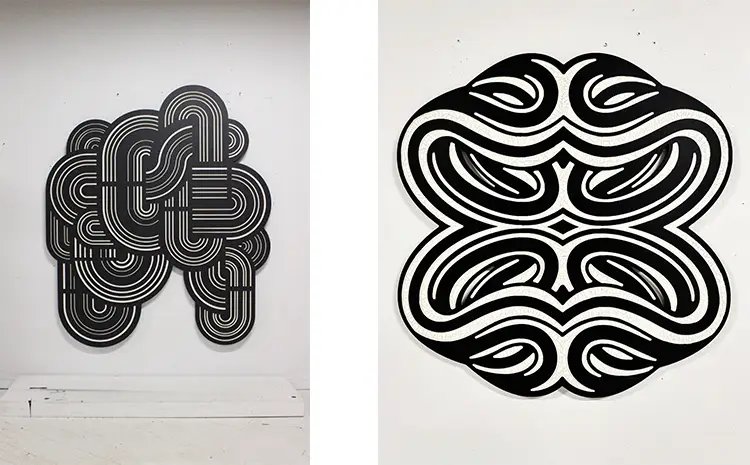
Emon Surakitkoson: From Restaurant Industry to Expansive Art Community
Beyond the studio, Surakitkoson’s presence is felt throughout Washington, D.C.’s art community. She has exhibited in galleries and institutions throughout the Washington, D.C. area. Her participation in community events further exemplifies her role as both a serious practitioner and a generous collaborator. By organizing events for emerging artists, she offers a platform for other creatives transitioning into the arts. These events celebrate the idea that passion, when nurtured, can become a profession.
Looking ahead, Surakitkoson envisions larger-scale sculptural installations, exploring collaborations with fabricators to extend the physical boundaries of her current practice. She also aims to expand internationally, pursuing residencies and grants that would allow her to engage with global artistic traditions—including a return to Thailand. These plans reflect both her desire to grow technically and her need to remain tethered to the cultural legacy that continues to shape her work.
Even as her reputation grows, Surakitkoson remains deeply rooted in personal authenticity. Her practice reflects an unwavering commitment to self-exploration and communal growth. In a landscape often dominated by trend-driven aesthetics, she offers something enduring: an invitation to pause, to look closely, and to consider how much power resides in quiet persistence.





